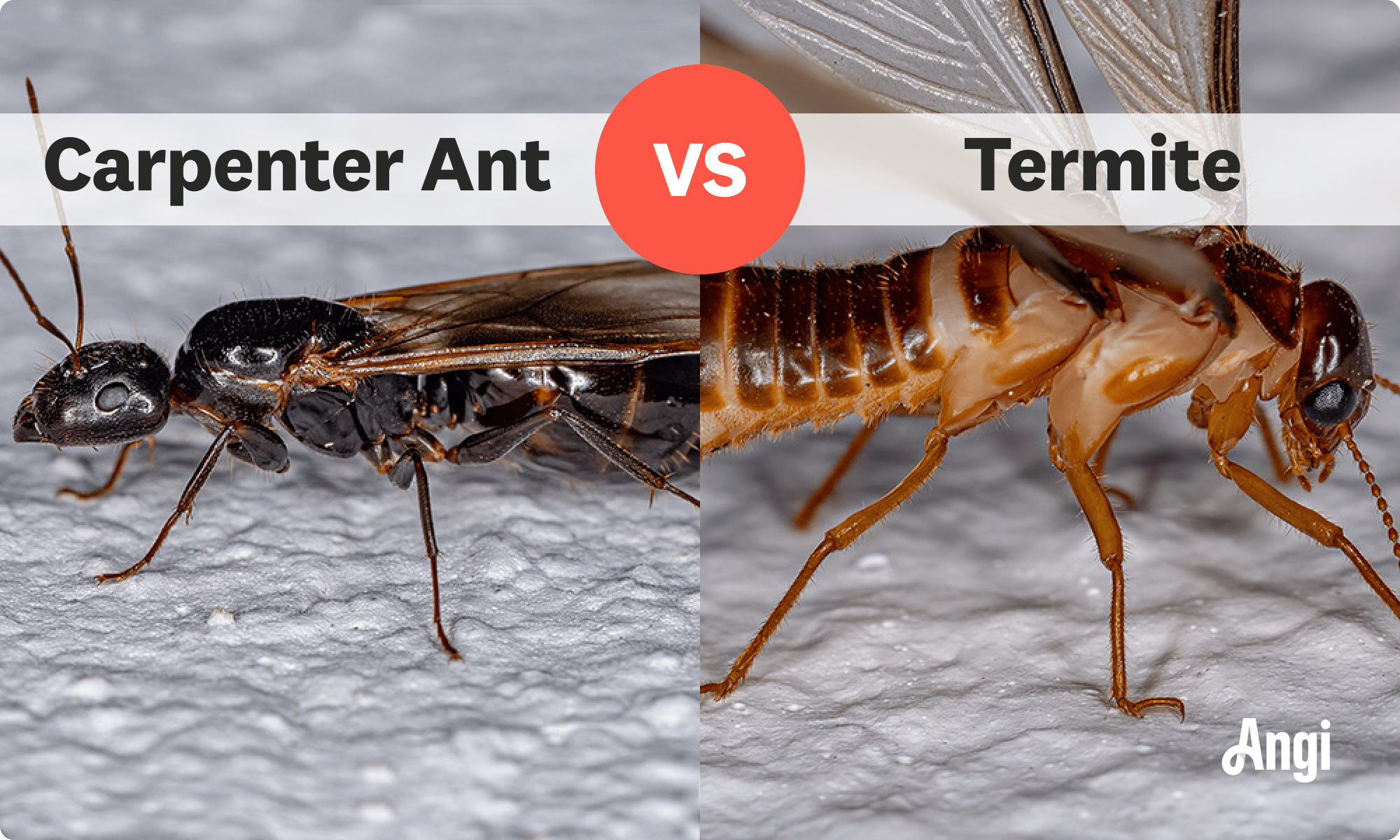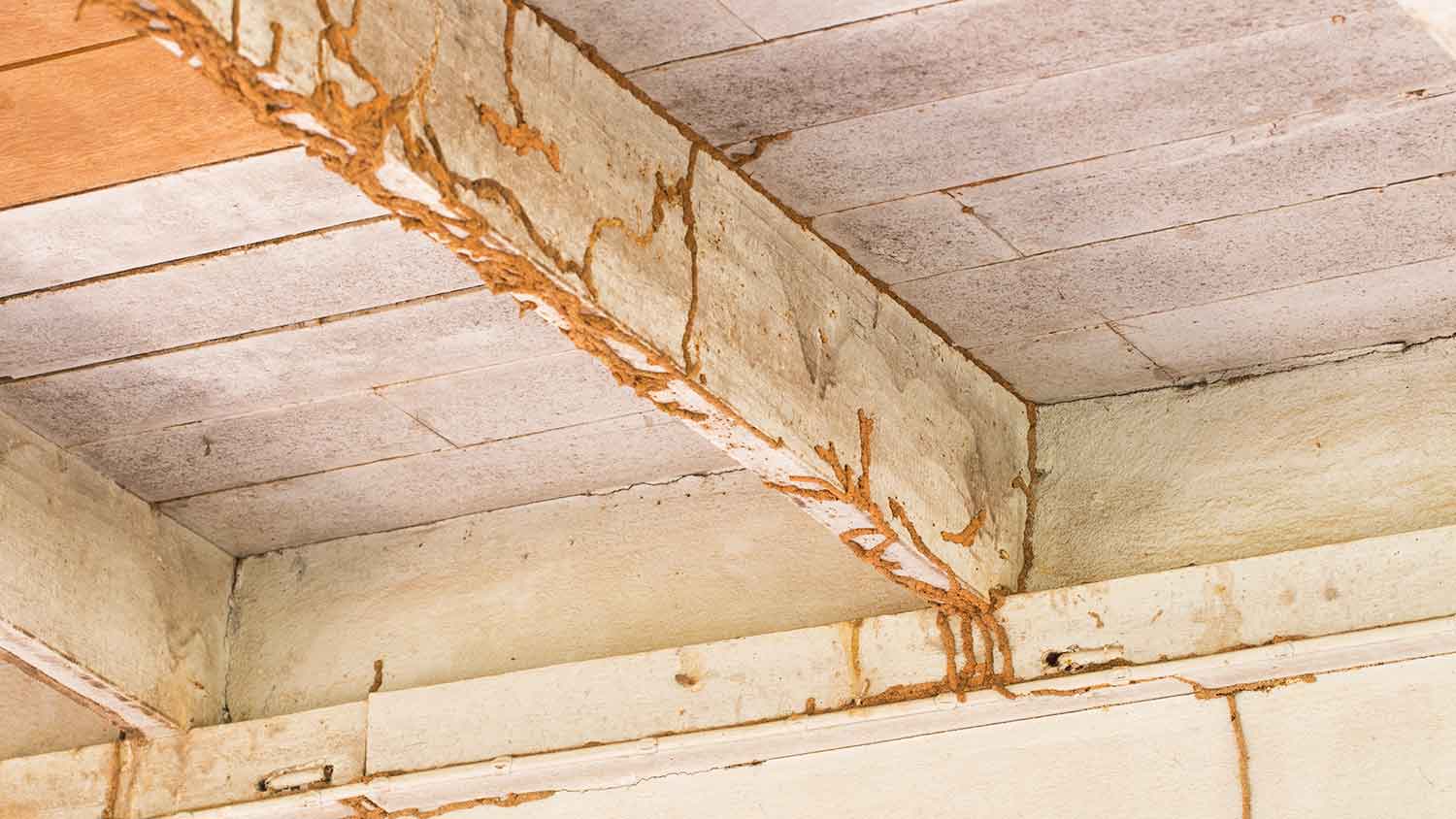
Whether you have bugs, bats, or rodents invading your home, you’ll want to contact an exterminator quickly. Find out how much pest control costs in Columbus, OH.
How to tell if your home is being nibbled by carpenter ants or termites


Both carpenter ants and termite have six legs.
Carpenter ants have more color variations than termites.
While ants will bite humans, termites keep their teeth to themselves.
While termites eat your wood frame, carpenter ants only burrow through it.
Wood damage at your home is the calling card sign of carpenter ants vs. termites. While both types of pests can cause extensive damage and rot, one is capable of sowing destruction much faster than the other. Keep reading to learn about how to identify the signs of carpenter ants and termites to prevent these pests from making a snack out of your home.

| Type of Difference | Carpenter Ants | Termites |
|---|---|---|
| Size | 6–12 mm | 5–15 mm |
| Color | Black, brown, and red | Red to brown |
| Number of Legs | Six | Six |
| Host Preference | None | None |
| Habitat | Outdoor | Indoor/outdoor dark, damp areas |
| Disease | Can carry disease | Do not carry disease |
Both carpenter ants and termites will damage the wood in your home, but you’ll see different patterns in how they do it.
Imagine an art farm where you can see the very smooth tunnels the ants built under the soil. This is the same for carpenter ant tunnels, except they build them in moist wood in your home and not under the soil. As carpenter ants tunnel, they will leave sawdust-like piles behind them. That’s because they don’t actually eat the wood, they’re carving it away to live inside of it instead.
When termites are inside your home, you won’t see sawdust, but you will spot mud tubes. Mud tubes are the structures where termites live. Unlike carpenter ants, they consume the wood in your home. Instead of smooth tunnels, you’ll see irregular gnaw marks, and the wood will be hollow thanks to the termites.
Other signs of termite damage include peeling paint, as they’re consuming the wood and cellulose behind the paint, plus hard-to-open windows and bubbling laminate floorboards, as they’ve eaten the wood underneath and the laminate is exposed to moisture.

Do carpenter ants and termites look alike? This guide may help you to identify your pest on the spot.
Most carpenter ants and termites are about 10 millimeters in size. The standard size for carpenter ants is between 6 millimeters and 12 millimeters. With sizes reaching 5 millimeters to 15 millimeters, wood termites generally outsize carpenter ants by a hair. It's even possible for an infamous "winged" swarmer termite species to reach 25 millimeters long.
The color of your pest can be a better indicator than its size. Shades of black, red, brown, orange, and yellow make the coloring of carpenter ants far richer than the standard dark-brown hue of most termite species.
Termites have long, oval-shaped bodies. While carpenter ants also have oval-shaped bodies, their heart-shaped heads make them stand out. Compared to carpenter ants, termites have shorter lets, thicker waists, and straighter antennae.
Both termites and carpenter ants are winged creatures. However, you can spot a carpenter ant by its front wings that are slightly larger than the back wings. A carpenter ant wings also have more of a "paddle" shape compared to a termite's pointed wings.
With termites and carpenter ants being six-legged creatures, counting extremities won't help you tell the difference. However, the trick for telling the difference is to look for the three distinct body segments found on the bodies of carpenter ants.

While carpenter ants and termites both destroy wood, their feeding habits are slightly different. In fact, termites and carpenter ants leave different footprints because only termites actually eat wood. Carpenter ants will only attack moist or rotting wood. While termites will also eat rotting wood, they will happily dive right into healthy and new wood.
Carpenter ants are simply digging through your wood for nest excavation. The telltale clues that you have carpenter ants are piles of wood shavings next to tiny holes in your wood. Galleries created by carpenter ants appear neat and efficient.
By contrast, termite galleries look sloppy because they have been filled in with layers of dirt and mud during feeding frenzies. If you see a mud tube on an outside wall of your home, this little passageway is the trademark sign of termites.
Termites and carpenter ants don't need hosts to survive. Their "host" is wood matter.
Termites do not bite people. While carpenter ants won't normally bite humans, they may attack with bites if something disturbs their nest. These painful pea-sized bites can break the skin. What's more, carpenter ants can spray a defensive chemical that causes the bite wound to sting.
Termites mostly swarm during daylight hours. They are most active after rainfall because they are attracted to moisture. Carpenter ants do most of their work after nightfall.

Most termites prefer to live in dry wood above ground level. Some species are soil dwellers. It's not uncommon to find termites living in walls, logs, furniture, and other sources of wood located either within or adjacent to a home. A professional termite removal service will search these areas for signs of damage during a termite inspection.
Carpenter ants typically nest in the wood of dead or decaying trees, branches, and stumps. Any rotting lumber that's next to or part of your home can also become a habitat for these pests.
A carpenter ant usually only lives six to 12 weeks. Each egg takes about 60 days to hatch into a full-grown worker ant. Due to their short lifespans, carpenter ants can take several years to build a colony. The entire colony can be wiped out quickly if the queen and workers are taken out.
Meanwhile, a termite can live for one to three years. This longer lifespan allows termites to create significant damage in your home. The queen of the colony can reign for decades, and ss she gets older, lay thousands of eggs in a single day.
While we don't generally need to worry about termites spreading disease, carpenter ants can carry salmonella, staph, E. coli, strep, and a variety of fungal diseases. If carpenter ants contaminate food sources, it can spread those diseases to humans.
Termites are not known to carry any diseases that are harmful to humans. The main health concern with termites is that their wood-destroying activity could trigger asthma attacks or allergic reactions in some people.
Due to their shared love of rotting wood, termites and carpenter ants require similar preventative measures.
Regular termite inspections from a qualified local termite expert is the best way to save your home from severe damage. With termite treatment costs ranging from $230 to $1,000, a quick inspection that keeps you ahead of the problem pays off.
Other ways to prevent termites include:
Address excess moisture around your home's foundation.
Eliminate wood-to-ground contact for decks and porches.
Use bait and monitoring systems.
Apply direct wood treatment to compromised wood.
Seal gaps around water and gas lines.
Fix leaky plumbing.
Seal cracks, crevices, and joints in your home.
Remove dead trees from your property.
Remove or elevate firewood.
Replace wood shingles.
The same rule about routine inspections applies for carpenter ants. Here are some other ways to get rid of carpenter ants and prevent them from infesting your home:
Address moisture areas around your home.
Cut back branches and tree limbs that create bridges to your home.
Seal cracks and openings near your foundation.
Seal areas where pipes and utility wires enter your home.
Remove or elevate firewood.
Eliminate wood-to-ground contact for decks and porches.
Avoid leaving food out.
Take trash out regularly.
From average costs to expert advice, get all the answers you need to get your job done.

Whether you have bugs, bats, or rodents invading your home, you’ll want to contact an exterminator quickly. Find out how much pest control costs in Columbus, OH.

Your mosquito misting system cost will vary based on factors such as the size, type, brand, and more. Find out what the budget for this system looks like.

Bats may have their benefits, but you don't want them taking up residence in your home. This guide will help you understand bat removal costs.

Ready to get bed bugs out of your home? With this guide, see the risks and benefits of using professional bed bug pesticides for the task.

Mice spread diseases, chew up your electrical wires, and eat anything and everything in your home. Get rid of mice fast, but humanely, with these easy tips.

“Water bugs” typically refer to a type of cockroach. Find out how to get rid of them instantly and keep them away for good in this handy DIY guide.